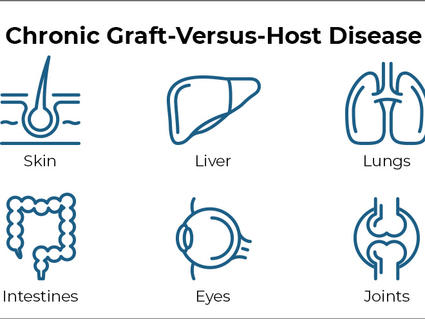Three-Drug Regimen Improves Protection against GVHD after Stem Cell Transplant
, by Carmen Phillips
Transplants using stem cells from a donor are essential treatments for people with blood cancers like lymphoma and leukemia. But donor transplants—known as allogeneic transplants—also harbor a substantial risk of a serious, and potentially fatal, side effect called graft-versus-host disease (GVHD).
A large clinical trial has identified a more effective way for reducing the risk of this dangerous complication.
In the clinical trial, funded in part by NCI, about 430 people who had an allogeneic transplant were randomly assigned to receive one of two treatments for preventing GVHD: The standard two-drug regimen of tacrolimus and methotrexate, or a more recently developed three-drug regimen anchored by the chemotherapy drug cyclophosphamide. All patients in the trial had transplants from closely matched donors.
One year after receiving the transplant, 53% of people in the three-drug group had not experienced GVHD and their cancer had not relapsed, compared with 35% of those in the two-drug group. The findings were reported June 22 in the New England Journal of Medicine.
“It’s clearly a very wide difference” between the groups, said the trial’s senior investigator, Javier Bolaños-Meade, M.D., of Johns Hopkins Kimmel Comprehensive Cancer Center. “This is the first time since the 1980s it’s been shown that something is clearly superior” to the standard two-drug treatment.
Treatment with the three-drug regimen, which also includes tacrolimus and mycophenolate, did not lead to more serious infections or a higher risk of the cancer coming back, Dr. Bolaños-Meade continued.
Both findings are particularly important, he said, because other treatments have been found to effectively protect against GVHD, but that protection came at the cost of more dangerous infections or the cancer returning.
“If [the patient] doesn’t develop GVHD but they relapse, that can’t be considered a success,” Dr. Bolaños-Meade said.
An effective treatment with a potentially serious drawback
For many people with blood cancers, allogeneic stem cell transplants can cure their disease.
The transplants, however, can extract a hefty physical price in some people. Even with preventive measures, up to half of people who get an allogeneic stem cell transplant develop GVHD. This condition occurs when immune cells that linger among the donated stem cells (the graft) view healthy cells in the patient (the host) as foreign or dangerous and attack them.
GVHD can occur shortly after the transplant, known as acute GVHD, and it can also arise months after the transplant, called chronic GVHD.
Painful skin rashes, severe nausea, and diarrhea are among the most common symptoms of acute GVHD, explained Salyka Sengsayadeth, M.D., who specializes in treating blood cancers at Vanderbilt University Medical Center. And if these symptoms are bad enough, Dr. Sengsayadeth said, they can be fatal.
These same symptoms are also common in chronic GVHD, along with frequent mouth sores, fatigue and weakness, and shortness of breath, among others. Chronic GVHD symptoms “mostly tend to affect [people’s] quality of life,” she noted, although occasionally they can be fatal as well.
The combination of methotrexate and drugs known as calcineurin inhibitors—of which tacrolimus is the most commonly used—has been the standard treatment to protect against GVHD since the 1980s. Dr. Bolaños-Meade is part of a team at Hopkins that led the way in studying the cyclophosphamide-based regimen—and not just in people with cancer, but also in those undergoing stem cell transplants for noncancer health conditions like sickle cell disease.
In this new trial, the research team wanted to confirm findings from a smaller clinical trial they had conducted that strongly suggested the cyclophosphamide-based three-drug regimen could substantially reduce GVHD risk in those receiving closely matched transplants.
Cyclophosphamide-based regimen shows multiple advantages
The trial was conducted at 37 cancer centers in the United States, under the auspices of the Blood and Marrow Clinical Trials Network. About half of the participants had acute myeloid leukemia; the remainder had other forms of leukemia, lymphoma, or a blood cancer called myelodysplastic syndrome.
Prior to their transplant, all patients in the trial received a reduced-intensity conditioning regimen. Conditioning regimens enable the donated stem cells to more readily take up residence in the bone marrow and begin reproducing.
The benefit of the three-drug regimen went beyond the improvement in GVHD-free, relapse-free survival at 1 year. In particular, when people treated with the cyclophosphamide-based regimen did develop acute or chronic GVHD, it tended to be less severe. And people who received the three-drug regimen also were less likely to need treatment to suppress an out-of-control immune response caused by the transplant.
However, it took longer for levels of platelets to return to normal in people in the three-drug group than the standard-treatment group (low platelet levels increase the risk of internal bleeding), and they also had a higher rate of lower-grade infections.
Based on the limited follow-up time (median time of 1 year), there is no difference in how long patients in either group have lived overall. The team will continue to follow participants to track survival and other measures, Dr. Bolaños-Meade said.
Changing treatment with allogeneic transplants
Excitement about the cyclophosphamide-based regimen in people receiving well-matched transplants began when the results from the smaller trial were reported in 2019, said the trial’s lead investigator, Shernan Holtan, M.D., of the University of Minnesota School of Medicine.
Combined with the results of this larger trial, which were presented late last year at the annual meeting of the American Society of Hematology, the impact on patient care is already being seen.
“I am hearing from colleagues around the globe that practice patterns are changing” based on the trial’s findings, Dr. Holtan continued. “This cyclophosphamide-based regimen could indeed become the new standard of care for [allogeneic stem cell transplants], especially considering the reduction in both severe acute and chronic GVHD.”
Another key aspect of the trial is that the median age of its participants was 66, Dr. Bolaños-Meade stressed. Most diagnoses of AML are in people aged 65 and older. And a decade or so ago, most oncologists were not willing to offer patients of that age a stem cell transplant, he noted.
But that has changed with the advent of reduced-intensity conditioning and improvements in the management of complications and side effects of transplantation.
It’s clear now, he stressed, that allogeneic stem cell transplants are “something that we can perform on our patients who are ‘elderly,’” he said. At Hopkins, he continued, “we have no age limit on who can get a transplant.”
At Vanderbilt, there hasn’t been a shift toward the use of the cyclophosphamide-based regimen yet in patients like those in this trial, Dr. Sengsayadeth said. But she expects that to change.
However, that doesn’t mean every patient will get the three-drug regimen. Cyclophosphamide can affect the heart, so the tacrolimus-methotrexate duo may be preferable for people with heart conditions, particularly those who are older, she said.
Moving toward using the three-drug regimen should be “relatively seamless,” Dr. Sengsayadeth continued. That’s because it’s already commonly used in people receiving allogeneic transplants that are only half matches, called haploidentical transplants, which carry a higher risk of GVHD than well-matched transplants.
The cyclophosphamide-based regimen has also proven to be effective in children and adults who have undergone more intensive conditioning prior to an allogeneic transplant, Dr. Holtan explained, and in people receiving what are called mismatched unrelated donor transplants.
Other options for protecting against GVHD are becoming available. One drug, abatacept (Orencia), was approved by the Food and Drug Administration in December 2021 to protect against acute GVHD in people undergoing allogeneic transplants, she said.
How best to use abatacept is still a challenge for those in the transplantation field, she added, and the cyclophosphamide-based regimen has advantages, including its “comparatively lower cost and … effectiveness in preventing chronic GVHD.”


